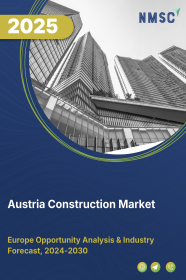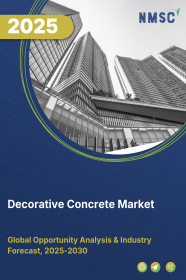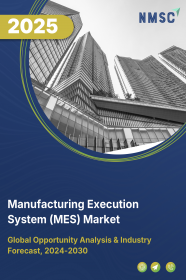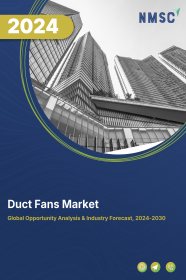
Austria Construction Market by Type (Renovation and New Construction), and by Sector (Real Estate, Infrastructure, and Industrial)–Opportunity Analysis and Industry Forecast, 2024–2030
Industry: Construction & Manufacturing | Publish Date: 24-Mar-2025 | No of Pages: 143 | No. of Tables: 108 | No. of Figures: 53 | Format: PDF | Report Code : CM2209
US Tariff Impact on Austria Construction Market
Trump Tariffs Are Reshaping Global Business
Austria Construction Market Overview
The Austria Construction Market size was valued at USD 48.99 billion in 2023, and is predicted to reach USD 67.52 billion by 2030, at a CAGR of 6.3% from 2024 to 2030.
The construction sector, also known as infrastructure, plays a vital role in the economy by overseeing the entire lifecycle of various physical structures, including infrastructure, buildings, and facilities. This industry encompasses a wide array of projects, ranging from residential, commercial, and industrial developments to civil engineering and institutional infrastructure endeavors.
Collaboration among various stakeholders, including architects, engineers, contractors, suppliers, developers, investors, and government agencies, is essential for its operations. Positioned for growth, the industry is being driven by an increased emphasis on environmentally sustainable practices, such as the integration of green building materials and energy-efficient designs. Furthermore, factors such as rising per capita income in emerging economies and low-interest rates in developed nations are expected to further propel the expansion of the infrastructure market.
Government Investment Driving Growth in Austria's Infrastructure Industry
Austria's construction industry is witnessing a surge in growth propelled by increased government investment in infrastructure projects, particularly in renewable energy industries and power grids. The government of Austria allocated substantial funds, amounting to USD 1.18 billion, in the Renewables Expansion Law (EAG) adopted in 2021.
This legislation aims to promote renewable power generation with the ambitious goal of producing 100% of the country's electricity from renewables by 2030. Additionally, the EAG includes provisions for investment grants and subsidies for solar, wind, and biomass projects, with an expected total investment reaching up to USD 35.4 billion over the next decade.
Expansion of Austria's Infrastructure Sector Driving Construction Market Growth
The significant growth in Austria's construction market can be attributed to the remarkable expansion of the infrastructure industry, that holds a substantial portion of the GDP. According to the UNECE report, the infrastructure sector accounted for 7.3% of Austria's GDP in 2022, outperforming nations such as Belgium, Bulgaria, and France. This substantial contribution of the infrastructure sector to Austria's GDP plays a crucial role in propelling the overall market expansion, indicating a positive outlook for the infrastructure industry in the country.
Regulatory Complexities is a Barrier to Construction Market Growth
In the construction market, overcoming regulatory complexities poses a significant challenge. Infrastructure projects often encounter obstacles due to the intricate web of government regulations and permitting procedures. Infrastructure endeavours demand numerous permits and approvals from governmental bodies at local, regional, and national levels.
These mandates encompass adherence to zoning regulations, environmental assessments, compliance with building codes, safety standards, and various regulatory stipulations. The lengthy process of acquiring permits, bureaucratic inefficiencies, and disparities in regulations among different jurisdictions can substantially prolong project timelines and inflate costs. Furthermore, fluctuations in regulations or unexpected policy changes can disrupt ongoing projects and deter potential investments.
Integration of Digitalization and BIM Presents Lucrative Opportunity for Market Expansion
The construction industry is undergoing a transformative phase with the integration of digitalization and the adoption of Building Information Modeling (BIM). By leveraging advanced technologies such as BIM, efficiency, accuracy, and collaboration across diverse projects are enhanced. BIM, a sophisticated 3D modeling tool, empowers stakeholders to generate and manage digital representations of structures and infrastructure, facilitating improved coordination and communication among project teams.
For example, in September 2022, the National Institute of Building Sciences (NIBS) initiated the Austria National Building Information Management (BIM) Program. This program aims to revolutionize the infrastructure sector, achieving unprecedented levels of industrial efficiency through digitalization. By addressing the inadequacy of digitalization within the Austria infrastructure sector, the initiative seeks to streamline lifecycle work processes, making them more efficient, cost-effective, resilient, and safer for infrastructure and maintenance.
Competitive Landscape
The market players operating in the Austria infrastructure industry include STRABAG SE, PORR AG, Swietelsky AG, Habau Group, Leyrer + Graf Baugesellschaft m.b.H., Doka Gmbh, Vasko + Partner Ingenieure, Webuild S.p.A., iC consulenten ZT GmbH, Bernard Gruppe, Pittel+Brausewetter GmbH, Felbermayr Holding GmbH, Alpen-Bau GmbH, Waagner-Biro, Mischek Systembau GmbH, and others.
Austria Construction Market Key Segments
By Type
-
Renovation
-
New Construction
By Sector
-
Real Estate
-
Residential
-
Affordable
-
Luxury
-
-
Commercial
-
Retail Buildings
-
Office Buildings
-
Hospitality
-
Healthcare Facilities
-
Educational Institutes
-
Entertainment Ventures
-
-
-
Infrastructure
-
Transportation
-
Airport
-
Port
-
Rail
-
Road
-
-
Water and Wastewater
-
Energy
-
Telecommunication
-
-
Industrial
-
Manufacturing Plant
-
Warehouses
-
Power Plants
-
Oil Refineries
-
Chemical Plants
-
Key players
-
STRABAG SE
-
PORR AG
-
Swietelsky AG
-
Habau Group
-
Leyrer + Graf Baugesellschaft m.b.H.
-
Doka Gmbh
-
Vasko + Partner Ingenieure
-
Webuild S.p.A.
-
iC consulenten ZT GmbH
-
Bernard Gruppe
-
Pittel+Brausewetter GmbH
-
Felbermayr Holding GmbH
-
Alpen-Bau GmbH
-
Waagner-Biro
-
Mischek Systembau GmbH
REPORT SCOPE AND SEGMENTATION:
|
Parameters |
Details |
|
Market Size in 2023 |
USD 48.99 Billion |
|
Revenue Forecast in 2030 |
USD 67.52 Billion |
|
Growth Rate |
CAGR of 6.3% from 2024 to 2030 |
|
Analysis Period |
2023–2030 |
|
Base Year Considered |
2023 |
|
Forecast Period |
2024–2030 |
|
Market Size Estimation |
Billion (USD) |
|
Growth Factors |
|
|
Companies Profiled |
15 |
|
Market Share |
Available for 10 companies |
|
Customization Scope |
Free customization (equivalent up to 80 working hours of analysts) after purchase. Addition or alteration to country, regional, and segment scope. |
|
Pricing and Purchase Options |
Avail customized purchase options to meet your exact research needs. |

















 Speak to Our Analyst
Speak to Our Analyst

















